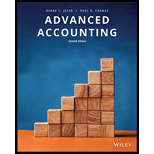
a.
Distinguish between book value and the value implied by the purchase price.
a.
Explanation of Solution
Book value is the price of the investment that is recorded in the books (financial statements) of subsidiary company on the date of acquisition. On the contrary, implied value is the total acquisition cost of investment of a subsidiary company on the date of acquisition.
b.
Distinguish between the excess of implied value over fair value.
b.
Explanation of Solution
The “excess of implied value over fair value” is known as
c.
Distinguish between the excess of fair value over implied value.
c.
Explanation of Solution
The “excess of fair value over implied value” is the excess of fair value of the identifiable net assets of a subsidiary company ( assets (except goodwill) minus liabilities) on the date of acquisition, over the value of the subsidiary, which is an implied payment made by the parent company. This is also known as bargain acquisition.
d.
Distinguish between the excess of book value over fair value.
d.
Explanation of Solution
The excess of book value over fair value defines a situation where few or all of the subsidiary’s assets are required to be written down rather than up that is either liability should be increased or both. However, it does not identify whether the acquisition will be resulting in the recording of goodwill or bargain acquisition. That measurement will rely on the evaluation of fair value of identifiable net assets and the implied value, and this is calculated as
Want to see more full solutions like this?
Chapter 5 Solutions
Advanced Accounting

 AccountingAccountingISBN:9781337272094Author:WARREN, Carl S., Reeve, James M., Duchac, Jonathan E.Publisher:Cengage Learning,
AccountingAccountingISBN:9781337272094Author:WARREN, Carl S., Reeve, James M., Duchac, Jonathan E.Publisher:Cengage Learning, Accounting Information SystemsAccountingISBN:9781337619202Author:Hall, James A.Publisher:Cengage Learning,
Accounting Information SystemsAccountingISBN:9781337619202Author:Hall, James A.Publisher:Cengage Learning, Horngren's Cost Accounting: A Managerial Emphasis...AccountingISBN:9780134475585Author:Srikant M. Datar, Madhav V. RajanPublisher:PEARSON
Horngren's Cost Accounting: A Managerial Emphasis...AccountingISBN:9780134475585Author:Srikant M. Datar, Madhav V. RajanPublisher:PEARSON Intermediate AccountingAccountingISBN:9781259722660Author:J. David Spiceland, Mark W. Nelson, Wayne M ThomasPublisher:McGraw-Hill Education
Intermediate AccountingAccountingISBN:9781259722660Author:J. David Spiceland, Mark W. Nelson, Wayne M ThomasPublisher:McGraw-Hill Education Financial and Managerial AccountingAccountingISBN:9781259726705Author:John J Wild, Ken W. Shaw, Barbara Chiappetta Fundamental Accounting PrinciplesPublisher:McGraw-Hill Education
Financial and Managerial AccountingAccountingISBN:9781259726705Author:John J Wild, Ken W. Shaw, Barbara Chiappetta Fundamental Accounting PrinciplesPublisher:McGraw-Hill Education





